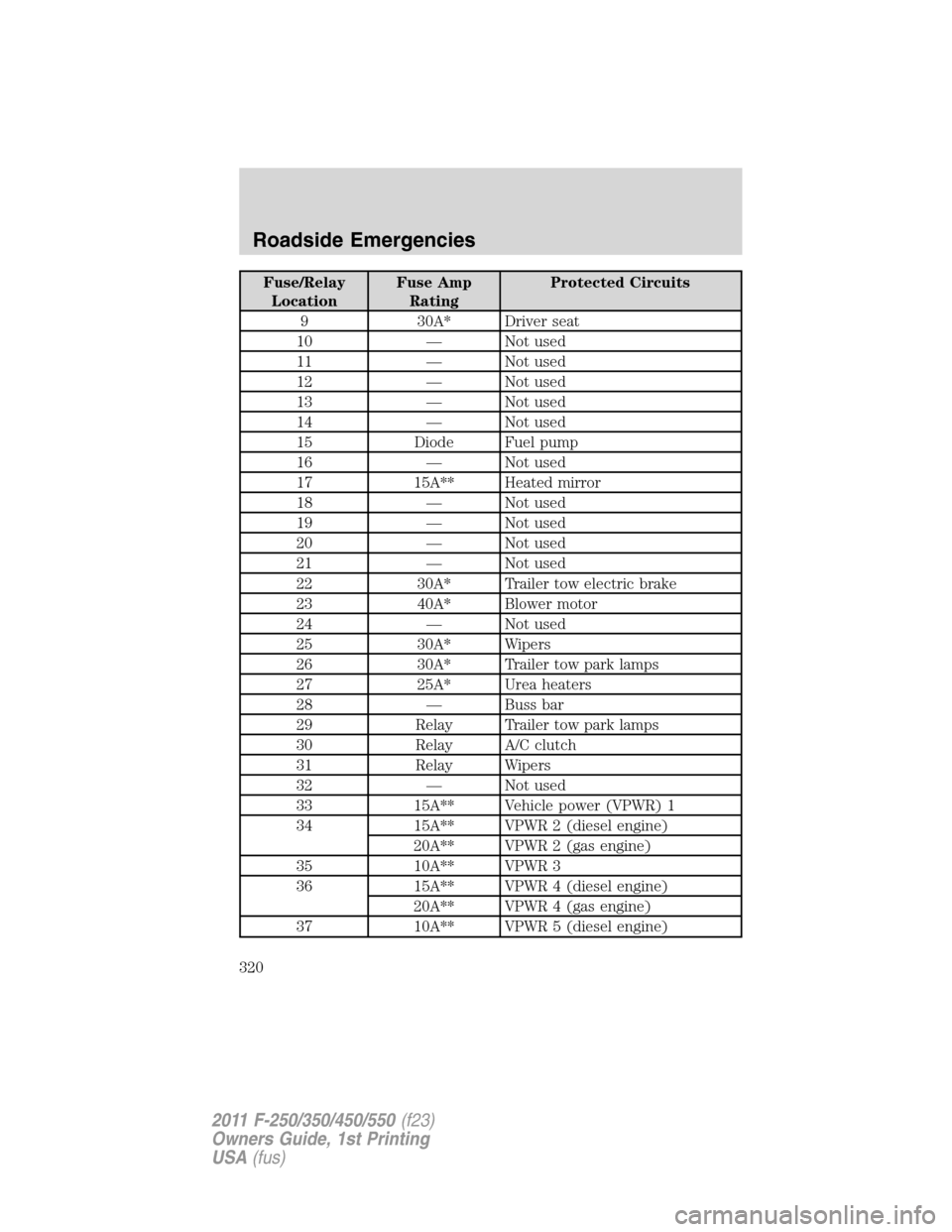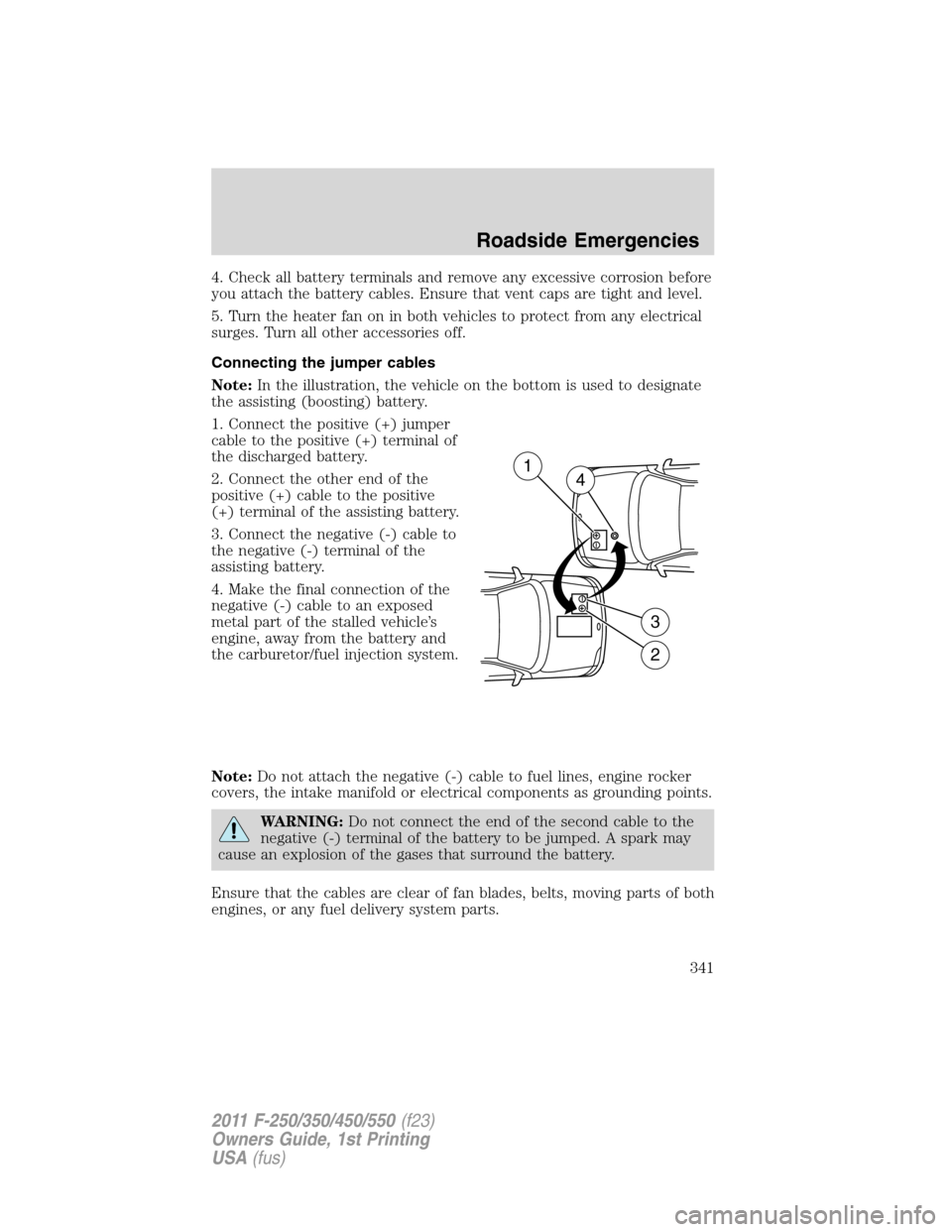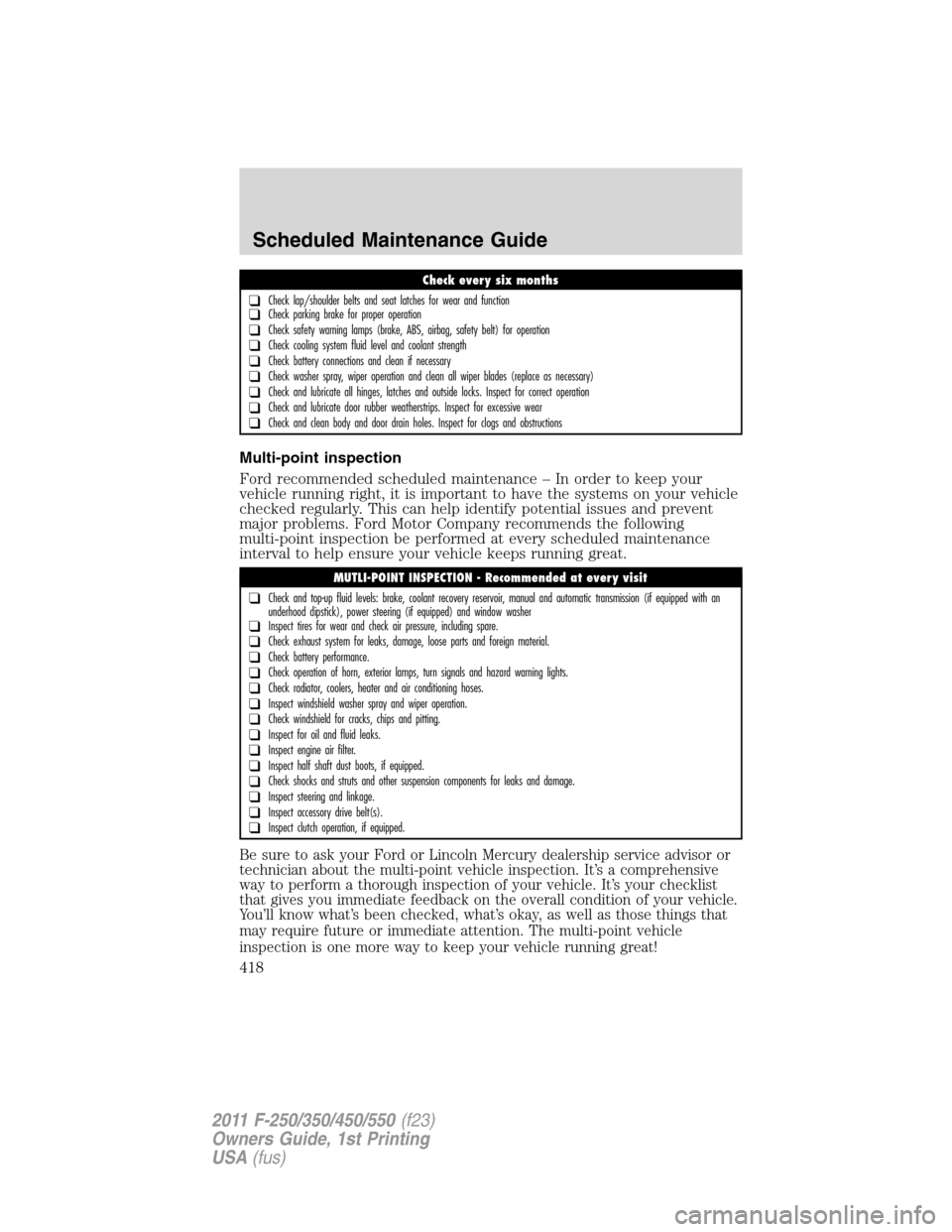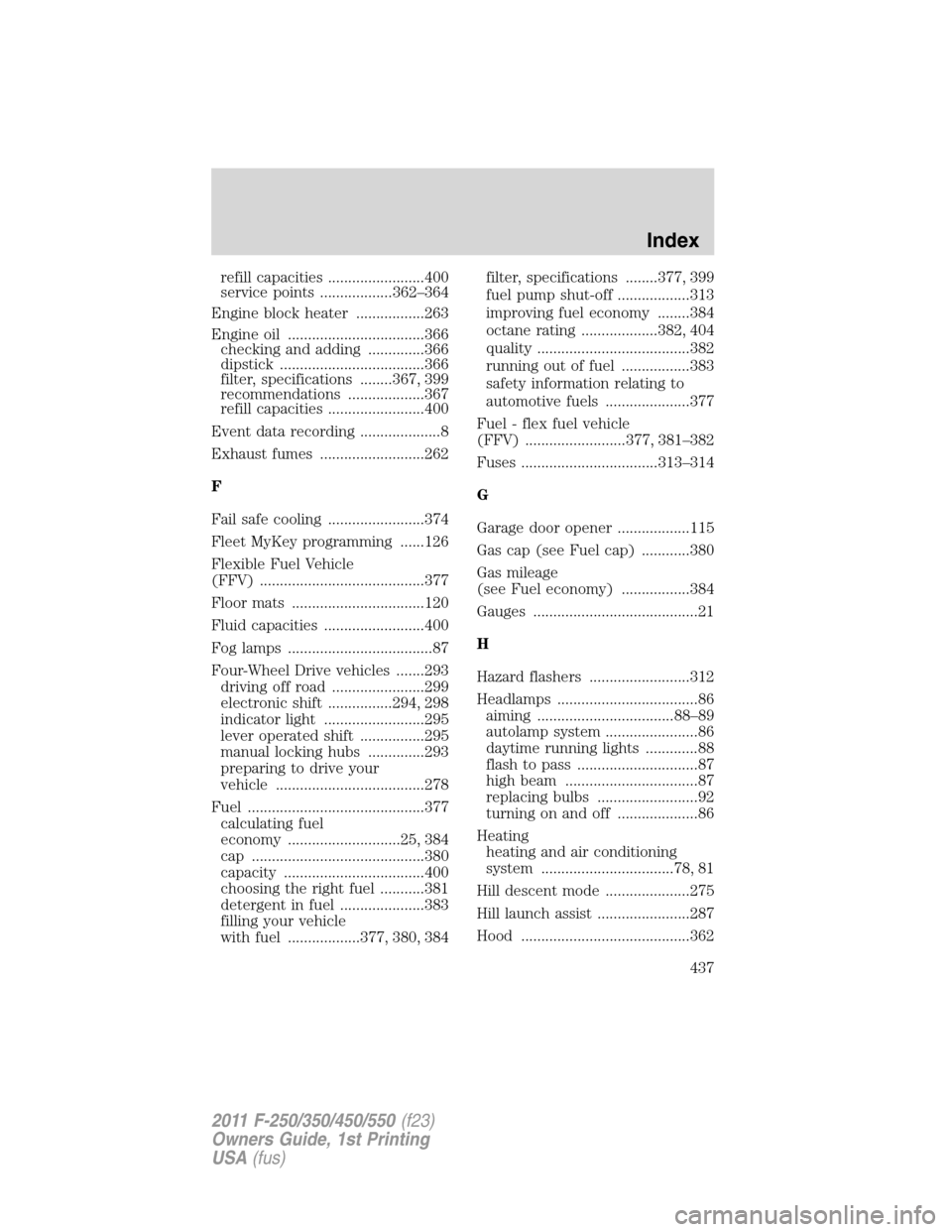2011 FORD SUPER DUTY heater
[x] Cancel search: heaterPage 318 of 441

Fuse/Relay
LocationFuse Amp
RatingProtected Circuits
30 15A Parking lamp relay, TT parking
lamp relay
31 5A Trailer brake controller (brake
signal), Customer access
32 15A Moon roof, Auto dimming mirrors,
Power invertor, Driver and
passenger door lock switch
illumination
33 10A Restraint control module
34 10A Not used (spare)
35 5A Select shift switch, Reverse park
aid module, Trailer brake control
module
36 10A Fuel tank select switch
37 10A PTC heater
38 10A Radio faceplate
39 15A High beam headlamps
40 10A Parking lamps (in mirrors), Roof
marker lamps
41 7.5A Passenger airbag deactivation
indicator
42 5A Not used (spare)
43 10A Wiper relay
44 10A Upfitter switches
45 5A Not used (spare)
46 10A Climate control
47 15A Fog lamps, Fog lamp indicator (in
switch)
48 30A Circuit
BreakerPower windows switch, Power
rear sliding window switch
49 Relay Delayed accessory
Roadside Emergencies
318
2011 F-250/350/450/550(f23)
Owners Guide, 1st Printing
USA(fus)
Page 319 of 441

Power distribution box
The power distribution box is located in the engine compartment. The
power distribution box contains high-current fuses that protect your
vehicle’s main electrical systems from overloads.
WARNING:Always disconnect the battery before servicing high
current fuses.
WARNING:To reduce risk of electrical shock, always replace
the cover to the power distribution box before reconnecting the
battery or refilling fluid reservoirs.
If the battery has been disconnected and reconnected, refer to the
Batterysection of theMaintenance and Specificationschapter.
The high-current fuses are coded as follows:
Fuse/Relay
LocationFuse Amp
RatingProtected Circuits
1 Relay Blower motor
2 — Not used
3 Relay Urea heaters
4 — Not used
5 Relay Rear window defroster
6 — Not used
7 40A* Rear window defroster
8 30A* Passenger seat
Roadside Emergencies
319
2011 F-250/350/450/550(f23)
Owners Guide, 1st Printing
USA(fus)
Page 320 of 441

Fuse/Relay
LocationFuse Amp
RatingProtected Circuits
9 30A* Driver seat
10 — Not used
11 — Not used
12 — Not used
13 — Not used
14 — Not used
15 Diode Fuel pump
16 — Not used
17 15A** Heated mirror
18 — Not used
19 — Not used
20 — Not used
21 — Not used
22 30A* Trailer tow electric brake
23 40A* Blower motor
24 — Not used
25 30A* Wipers
26 30A* Trailer tow park lamps
27 25A* Urea heaters
28 — Buss bar
29 Relay Trailer tow park lamps
30 Relay A/C clutch
31 Relay Wipers
32 — Not used
33 15A** Vehicle power (VPWR) 1
34 15A** VPWR 2 (diesel engine)
20A** VPWR 2 (gas engine)
35 10A** VPWR 3
36 15A** VPWR 4 (diesel engine)
20A** VPWR 4 (gas engine)
37 10A** VPWR 5 (diesel engine)
Roadside Emergencies
320
2011 F-250/350/450/550(f23)
Owners Guide, 1st Printing
USA(fus)
Page 341 of 441

4. Check all battery terminals and remove any excessive corrosion before
you attach the battery cables. Ensure that vent caps are tight and level.
5. Turn the heater fan on in both vehicles to protect from any electrical
surges. Turn all other accessories off.
Connecting the jumper cables
Note:In the illustration, the vehicle on the bottom is used to designate
the assisting (boosting) battery.
1. Connect the positive (+) jumper
cable to the positive (+) terminal of
the discharged battery.
2. Connect the other end of the
positive (+) cable to the positive
(+) terminal of the assisting battery.
3. Connect the negative (-) cable to
the negative (-) terminal of the
assisting battery.
4. Make the final connection of the
negative (-) cable to an exposed
metal part of the stalled vehicle’s
engine, away from the battery and
the carburetor/fuel injection system.
Note:Do not attach the negative (-) cable to fuel lines, engine rocker
covers, the intake manifold or electrical components as grounding points.
WARNING:Do not connect the end of the second cable to the
negative (-) terminal of the battery to be jumped. A spark may
cause an explosion of the gases that surround the battery.
Ensure that the cables are clear of fan blades, belts, moving parts of both
engines, or any fuel delivery system parts.
+–
+–
2
3
14
Roadside Emergencies
341
2011 F-250/350/450/550(f23)
Owners Guide, 1st Printing
USA(fus)
Page 418 of 441

Multi-point inspection
Ford recommended scheduled maintenance – In order to keep your
vehicle running right, it is important to have the systems on your vehicle
checked regularly. This can help identify potential issues and prevent
major problems. Ford Motor Company recommends the following
multi-point inspection be performed at every scheduled maintenance
interval to help ensure your vehicle keeps running great.
Be sure to ask your Ford or Lincoln Mercury dealership service advisor or
technician about the multi-point vehicle inspection. It’s a comprehensive
way to perform a thorough inspection of your vehicle. It’s your checklist
that gives you immediate feedback on the overall condition of your vehicle.
You’ll know what’s been checked, what’s okay, as well as those things that
may require future or immediate attention. The multi-point vehicle
inspection is one more way to keep your vehicle running great!
Check every six months
❑Check lap/shoulder belts and seat latches for wear and function❑Check parking brake for proper operation
❑Check safety warning lamps (brake, ABS, airbag, safety belt) for operation
❑Check cooling system fluid level and coolant strength
❑Check battery connections and clean if necessary
❑Check washer spray, wiper operation and clean all wiper blades (replace as necessary)
❑Check and lubricate all hinges, latches and outside locks. Inspect for correct operation
❑Check and lubricate door rubber weatherstrips. Inspect for excessive wear
❑Check and clean body and door drain holes. Inspect for clogs and obstructions
MUTLI-POINT INSPECTION - Recommended at every visit
❑Check and top-up fluid levels: brake, coolant recovery reservoir, manual and automatic transmission (if equipped with an
underhood dipstick), power steering (if equipped) and window washer
❑Inspect tires for wear and check air pressure, including spare.
❑Check exhaust system for leaks, damage, loose parts and foreign material.
❑Check battery performance.
❑Check operation of horn, exterior lamps, turn signals and hazard warning lights.
❑Check radiator, coolers, heater and air conditioning hoses.
❑Inspect windshield washer spray and wiper operation.
❑Check windshield for cracks, chips and pitting.
❑Inspect for oil and fluid leaks.
❑Inspect engine air filter.
❑Inspect half shaft dust boots, if equipped.
❑Check shocks and struts and other suspension components for leaks and damage.
❑Inspect steering and linkage.
❑Inspect accessory drive belt(s).
❑Inspect clutch operation, if equipped.
Scheduled Maintenance Guide
418
2011 F-250/350/450/550(f23)
Owners Guide, 1st Printing
USA(fus)
Page 437 of 441

refill capacities ........................400
service points ..................362–364
Engine block heater .................263
Engine oil ..................................366
checking and adding ..............366
dipstick ....................................366
filter, specifications ........367, 399
recommendations ...................367
refill capacities ........................400
Event data recording ....................8
Exhaust fumes ..........................262
F
Fail safe cooling ........................374
Fleet MyKey programming ......126
Flexible Fuel Vehicle
(FFV) .........................................377
Floor mats .................................120
Fluid capacities .........................400
Fog lamps ....................................87
Four-Wheel Drive vehicles .......293
driving off road .......................299
electronic shift ................294, 298
indicator light .........................295
lever operated shift ................295
manual locking hubs ..............293
preparing to drive your
vehicle .....................................278
Fuel ............................................377
calculating fuel
economy ............................25, 384
cap ...........................................380
capacity ...................................400
choosing the right fuel ...........381
detergent in fuel .....................383
filling your vehicle
with fuel ..................377, 380, 384filter, specifications ........377, 399
fuel pump shut-off ..................313
improving fuel economy ........384
octane rating ...................382, 404
quality ......................................382
running out of fuel .................383
safety information relating to
automotive fuels .....................377
Fuel - flex fuel vehicle
(FFV) .........................377, 381–382
Fuses ..................................313–314
G
Garage door opener ..................115
Gas cap (see Fuel cap) ............380
Gas mileage
(see Fuel economy) .................384
Gauges .........................................21
H
Hazard flashers .........................312
Headlamps ...................................86
aiming ..................................88–89
autolamp system .......................86
daytime running lights .............88
flash to pass ..............................87
high beam .................................87
replacing bulbs .........................92
turning on and off ....................86
Heating
heating and air conditioning
system .................................78, 81
Hill descent mode .....................275
Hill launch assist .......................287
Hood ..........................................362
Index
437
2011 F-250/350/450/550(f23)
Owners Guide, 1st Printing
USA(fus)